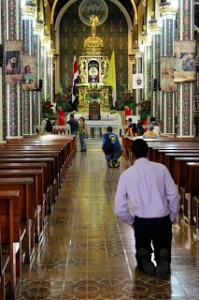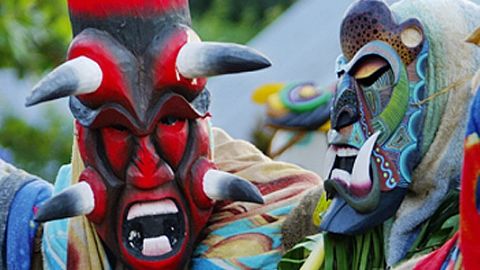Costa Rica Living – Costa Rica has many non-US or non-Colombian traditions and culture. A predominantly Catholic country, Costa Rica’s original tribes were first introduced to Catholicism in 1502 when Christopher Columbus landed the country on his last voyage. The tribes survived by hunting, foraging, fishing, and farming mostly beans, corn, potatoes, and coffee. Coffee became popular in the 1800’s and farmers were granted coffee-producing lands. They became rich overnight by exporting coffee to Europe.
 Costa Ricans are warm, friendly, and rarely raise their voices when they’re angry. They smile at each other in public places and make friendly eye contact. Friends shake hands to greet each other, while families and relatives kiss on the cheeks. Family ties are important and parents are closely involved with their children. There are many traditions that revolve around family up to the extended families, including baptism, first communions, weddings, and funerals.
Costa Ricans are warm, friendly, and rarely raise their voices when they’re angry. They smile at each other in public places and make friendly eye contact. Friends shake hands to greet each other, while families and relatives kiss on the cheeks. Family ties are important and parents are closely involved with their children. There are many traditions that revolve around family up to the extended families, including baptism, first communions, weddings, and funerals.
Being a conservative nation, young adults, particularly women, are trained to dress modestly and speak graciously. Although double-standard is obvious but acceptable, women are given equal opportunity to work like men do, except in some harsher environments. As in other tropic or warmer countries, Costa Rican’s bathe at least once or twice a day. Aside from family traditions, there are main religious celebrations throughout the year, as in other catholic countries, like Holy Week, Christmas, and feasts of patron saints.
There are many more traditions observed by Ticos, and others are specific to a location, so let’s start off with Virgen de Los Angeles. In 1824, the Virgen de la Negrita was declared the patron saint of Costa Rica. On August 2, 1635, the La Negrita was originally found on the same spot as the Basilica Los Angeles in Cartago, the shrine the natives built to house the Virgen. Yearly on August 2nd, patrons walk 22km from San Jose to the Basilica as penitence.
Come February of each year, CR celebrates the ethnic festival Fiesta de los Diablitos. This tradition goes back to the colonial era when Indians fight the invading Spaniards. People are in masks and costumes representing Diablitos taking on a bull (represents a Spaniard). There’s much role-playing, recreating fight scenes, and music.
Costa Ricans also celebrate the day when Christopher Columbus discovered the country. Yearly in October, Limon celebrates the Day of the Culture Encounter for a whole week. The people fill up the streets every day to watch and attend parties, parades, beauty contests, and concerts featuring reggae and salsa.
Christmas is celebrated everywhere in the world and Costa Rica has a different way of celebrating this holiday season. During the last few days of November, Costa Ricans start decorating their houses with cypress trees and cypress vines. San Jose starts the Christmas holiday by celebrating the Festival de la Luz with floats, orchestra, street dancing, and partying. Surprisingly for this country, they don’t believe in Santa Claus, instead, Baby Jesus brings the gifts to the children the night before La Noche Buena. Don’t forget the tamales, the family’s favorite dish for this very special dinner.
Ticos love their fiestas. They can have up to 4-5 festivals in a month. Some even last for an entire week.
The pura vida attitude usually means that if there is a reason to not work then it will be celebrated.

